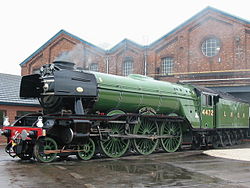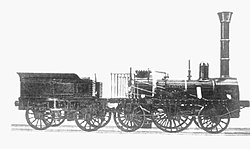Steam locomotive
A steam locomotive is a steam powered railway locomotive. It was used a lot between about 1830 and 1970. Afterwards, diesel and electric locomotives were used more often. The first steam locomotive was made by Richard Trevithick for a railway used for moving iron at an Ironworks in Wales. A steam locomotive works by burning a fuel like coal in a special space called a firebox. This produces hot gases that rise and go through tubes in a boiler - a large space with water in it. This heats the water, producing steam. The steam is then taken through another tube to a cylinder. The steam then pushes the piston which in turn pushes a metal rod that is connected to the wheels, making the locomotive move. The steam then rises out through the chimney.
Early in the 19th century, steam locomotives were created in the UK, and they were utilized for railroad transportation until the mid-1900s.Steam locomotives are still today used in many developing countries where the railways have not yet been electrified.
Steam Locomotive Media
LNER Class A4 4468 Mallard is officially the fastest steam locomotive, reaching 126 mph (203 km/h) on 3 July 1938.
LNER Class A3 4472 Flying Scotsman was the first steam locomotive to officially reach 100 mph (160 km/h), on 30 November 1934.
Union Pacific Big Boy 4014 is the largest operating steam locomotive in the world.
41 018 climbing the Schiefe Ebene with 01 1066 as pusher locomotive (video 34.4 MB)
The Salamanca locomotive
The Locomotion at Darlington Railway Centre and Museum
A 1848 scale model of the La Gironde in a museum at Le Creusot
Steam locomotive 2-8-2 at train station
Other websites
| Wikimedia Commons has media related to Lua error in Module:Commons_link at line 62: attempt to index field 'wikibase' (a nil value).. |
- GKB 671:The longest serving steam locomotive in the world (since 1860)
- Database of surviving steam locomotives in North America
- Information on North American steam railroads in operation
- UK heritage railways and preserved locomotives database
- Pages for the British project to build a modern steam locomotive. The Advanced Steam Locomotive. (5AT)
- International Steam Locomotives Archived 2010-02-18 at the Wayback Machine
- Tracks of Time Archived 2009-06-05 at the Wayback Machine









